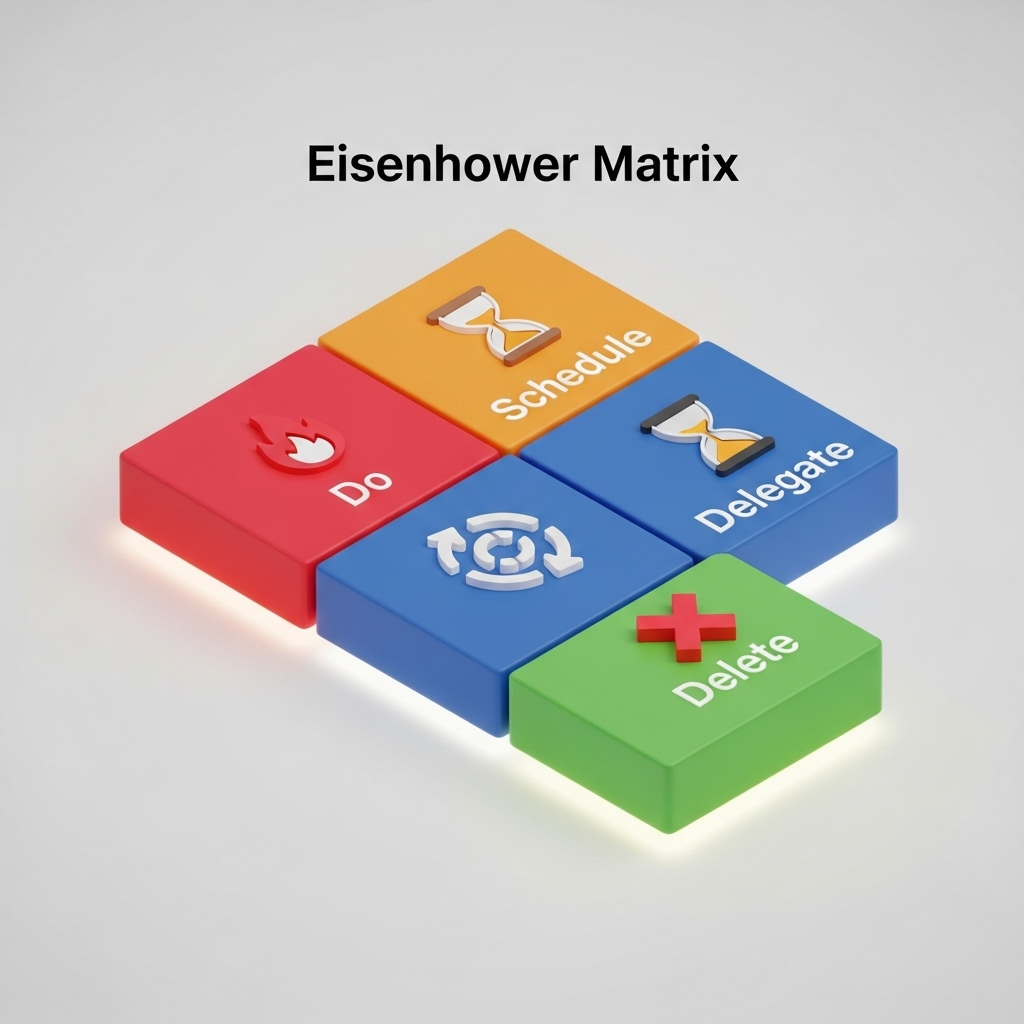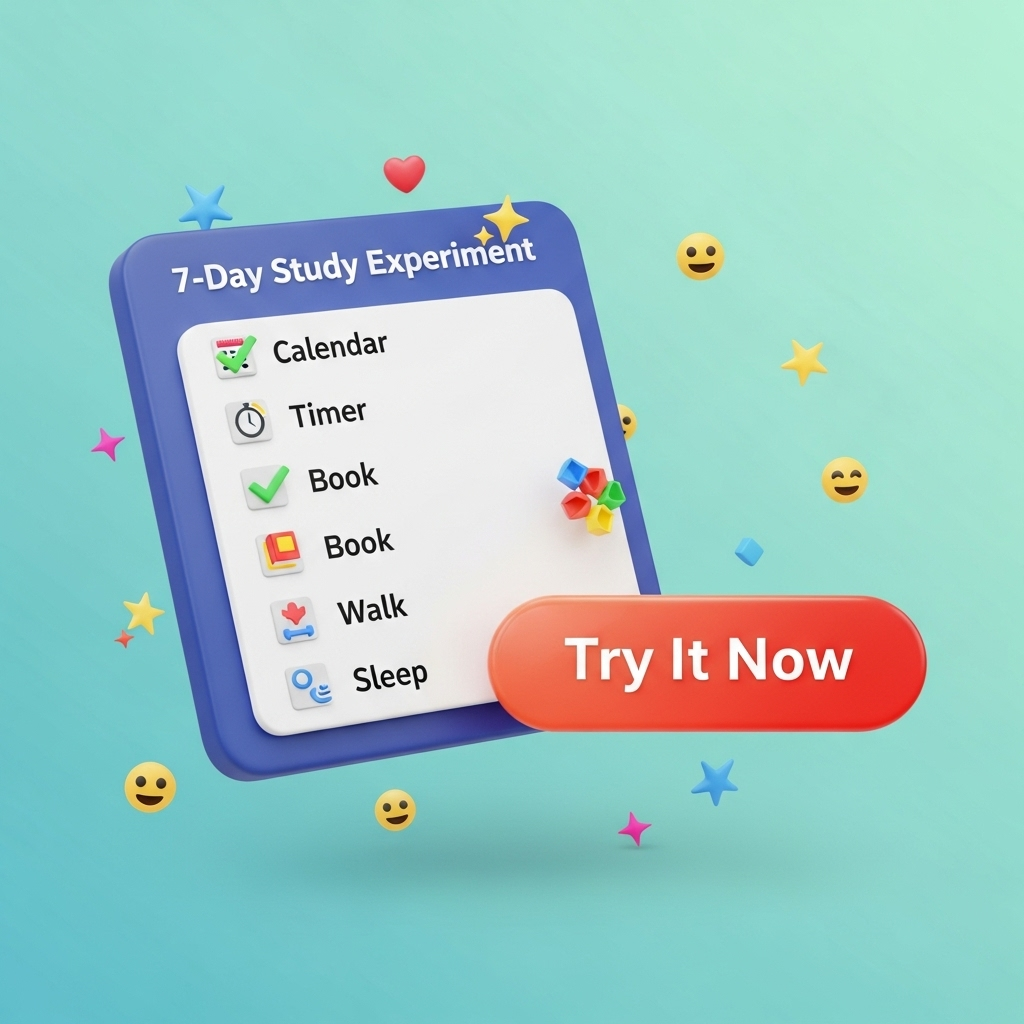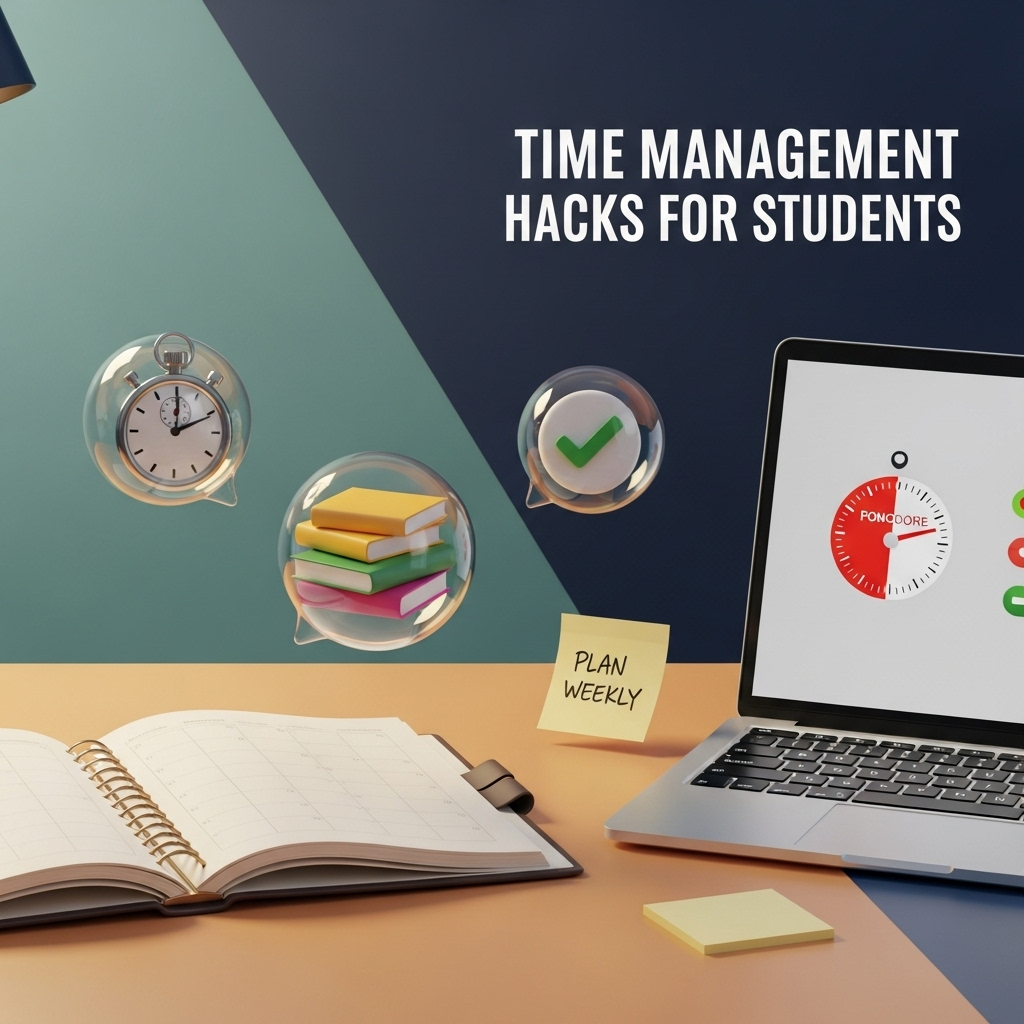Time Management Introduction — the secret weapon is not willpower, it’s systems
If you’re a student juggling classes, assignments, part-time work, and a social life, time management probably feels like a myth. The real secret? Not more willpower — but small systems you can follow reliably. In this guide I’ll share practical, research-backed time management hacks you can use today: priority frameworks, focus rituals, scheduling tricks, and real workflows I’ve tested with students. Most of these are free, fast to adopt, and designed to reduce friction so you actually do the work you plan.
Time Management Why these hacks — quick evidence summary
These techniques aren’t trendy — they’re rooted in research and decades of productivity practice. The Pomodoro Technique gives structure to focused work; prioritization frameworks like the Eisenhower Matrix help students decide what actually moves the grade needle; avoiding multitasking is supported by cognitive research; and spaced practice beats cramming for long-term retention. Below I link to the core ideas and give exact, actionable steps you can use right away. Pomodoro TechniqueThe Decision LabStanford NewsScienceDirect
1) Time Management Rule #1 — Treat time like currency: plan weekly, not just daily
Most students plan day-to-day and then get surprised by deadlines. Instead, allocate one 30–45 minute block each Sunday to plan the upcoming week. Break the week into:
- Fixed commitments: classes, labs, work shifts.
- Priority study blocks: two to four fixed study sessions (90–120 mins each if possible).
- Buffer/maintenance: admin, emails, light review.
Use a calendar app (Google Calendar, TickTick) and block time — treat those blocks as non-negotiable. If you want a single tool stack, use Notion or Todoist for tasks + a calendar for time blocking (readers on PaidScripts can check our E-learning Tools section for recommendations).

2) Time Management Pomodoro + Deep Work combo — short sprints, then deep sessions
Pomodoro (25 minutes work + 5 minute break) is a brilliant starter because it lowers the activation energy to begin. Francesco Cirillo’s Pomodoro® Technique helps you convert “I’ll study later” into “I’ll do 25 minutes now.” For conceptually heavy work (projects, coding, problem sets), pair Pomodoro sprints into longer deep-work windows (2–3 Pomodoros → 15–30 minute break) to sustain cognitive intensity. This blends the immediate momentum of Pomodoro with the deep concentration advocated by Cal Newport’s Deep Work. Pomodoro TechniqueRunn
How to use it (example):
- 25 / 5 Pomodoro × 3 = 75 minutes focused → 20 minute deep break (walk, coffee).
- Track sessions in a simple log: topic, Pomodoros completed, stuck points.

3) Time Management Prioritize using the Eisenhower Matrix — important beats urgent
Students often confuse “urgent” (deadline today) with “important” (deep learning that improves grades). Apply the Eisenhower Matrix:
- Do (Urgent & Important): assignments due soon.
- Schedule (Not urgent but Important): exam prep, project planning.
- Delegate (Urgent but not Important): group admin tasks you can assign.
- Delete (Neither): social scrolling, low-value meetings.
This simple sorting avoids the frantic firefighting that destroys deep study time. If you’re using a task manager, tag items by quadrant and schedule the “Schedule” tasks into your weekly blocks. The Decision Lab
4) Time Management Batch similar tasks — reduce context switching cost
Switching between different cognitive modes costs time. Batch small, similar tasks together: emails & admin in one block, reading & note extraction in another, practice problems in a third. This reduces setup time and improves flow. For example, do all quick marking, replies, and minor edits in a 30-minute “admin” block rather than scattered throughout the day.
5) Time Management Kill multitasking — single-tasking is faster
Multiple studies (including a key Stanford study) show that heavy media multitaskers perform worse on tasks requiring cognitive control. Multitasking is an illusion of efficiency — it fragments attention and increases time spent overall. When you need to learn, close extra tabs, silence notifications, and use a focus timer (Forest, Pomodoro apps) to protect one task at a time. Stanford News
6) Time Management Use the “Two-Minute Rule” and “Five-Minute Sweep”
David Allen’s two-minute rule (if a task takes <2 minutes, do it now) is perfect for students drowning in tiny to-dos. Complement it with a daily five-minute sweep at the top of each study session: tidy your desk, open the right tabs, load files — this small ritual prevents friction that kills momentum.
7) Time Management Spaced repetition & active recall — study smarter, not longer
Time management isn’t just about scheduling: it’s about the type of study. Spaced repetition and retrieval practice produce far better long-term retention than rereading or last-minute cramming. Use flashcards (Anki) or schedule short review sessions for material you’ve already learned — it’s an efficient way to maintain knowledge with minimal time. A growing body of evidence supports spaced and interleaved practice for durable learning. ScienceDirectUSA.edu
8) Create friction for distractions — design your environment
Make distractions harder: phone in another room, browser extension to block social sites during work (uBlock/StayFocusd), or a dedicated study profile on your laptop with only essential apps. Conversely, make it easy to resume: keep a “next steps” note on your desktop so when a break ends you know exactly where to pick up. Small environmental tweaks reduce decision fatigue and preserve willpower.
9) Use micro-deadlines & accountability partners
Break big projects into micro-deadlines (today: outline; Tuesday: rough draft; Friday: revise). Share these with a peer or study group — social accountability drastically raises the odds you’ll meet a deadline. If you can, do short paired sessions (50 minutes work + 10 minutes check-in) with a friend — the social rhythm helps maintain consistent effort.
10) Track your time for one week — find your hidden leaks
We often misjudge where our time goes. Try a one-week audit using a simple log or RescueTime (passive tracking). Compare planned vs actual: are you spending 3 hours on passive browsing instead of 3 hours of focused study? Knowing the gap lets you target the biggest time leaks first.
11) Sleep, nutrition, and micro-recovery are time multipliers
Poor sleep and nutrition erode study efficiency. An hour of focused, well-rested study can beat three hours of tired, distracted reading. Schedule short recovery breaks (walks, power naps) between study blocks — they restore cognitive energy and improve retention. Treat sleep as a non-negotiable study resource, not optional downtime.
12) Tools & templates that help (free & practical)
- Pomodoro apps: Forest, TomatoTimer, or built-in timers in TickTick. Pomodoro Technique
- Task planners: Todoist, Notion, MyStudyLife for class schedules.
- Blocking: StayFocusd / LeechBlock to restrict distracting sites.
- Spaced repetition: Anki, Quizlet for active recall.
- Time trackers: RescueTime for honest audit insights. ScienceDirectUSA.edu
Comparison Table — Quick picks by student type
| Student Type | Recommended Stack | Why it works |
|---|---|---|
| Highly distractible | Forest + Todoist | Gamified focus + simple tasks |
| Project heavy | Notion + Pomodoro | Project hub + focused execution |
| Exam prep | Anki + Time-blocked calendar | Spaced recall + scheduled reviews |
| Busy & juggling jobs | TickTick (Pomodoro + tasks) | All-in-one, low overhead |
Real student story — small change, big result
I coached a student who was failing to finish lab reports. We swapped her vague “study tonight” habit for a weekly plan and two 90-minute dedicated lab blocks. She used Pomodoro for focus and a nightly five-minute checklist. Within three weeks she went from late submissions to on-time plus a 15% grade bump — not because she studied more hours, but because her time finally aligned with the tasks that mattered.

Practical 7-day experiment (do this)
- Pick one planner + one focus tool.
- Do a 10-minute Sunday plan for the week.
- Run two focused sessions daily (25/50 mins) and log them.
- Do a one-week time audit and review on Sunday.
- Iterate: move or remove one low-value habit.
Commit to this for 7 days and you’ll see small but measurable shifts.
Conclusion — build tiny, repeatable systems
Time management is a muscle you build with simple systems: weekly planning, Pomodoro + deep work, prioritization with the Eisenhower Matrix, batching, and spaced practice. The hacks above are small, actionable, and research-backed — apply one or two at a time and let them compound. Remember: the goal is not busyness — it’s consistent progress.
Sources & further reading
- Pomodoro® Technique (official) — Francesco Cirillo. Pomodoro Technique
- The Eisenhower Matrix — concept & tutorial. Eisenhower –
- Stanford research on multitasking and cognitive control. Stanford News
- Spaced learning & retrieval practice research review. ScienceDirect
- Practical study techniques & retrieval practice guides. USA.edu
For more tips on leveraging technology for academic success, check out our guide on Top AI Tools for Study Faster in 2025




Pingback: Top AI Tools for Study Faster in 2025: Boost Productivity & Grades - PaidScripts — Tech Education Hub: Coding, Courses & Student Resources
Pingback: Top 10 Online Learning Platforms in 2025 for Students - PaidScripts — Tech Education Hub: Coding, Courses & Student Resources
Pingback: 15 Study Hacks for Exams - PaidScripts -Tech Education Hub: Courses & Student Resources
Pingback: 15 Free Online Certification Courses to Boost Your Career in 2025 - PaidScripts -Tech Education Hub: Courses & Student Resources